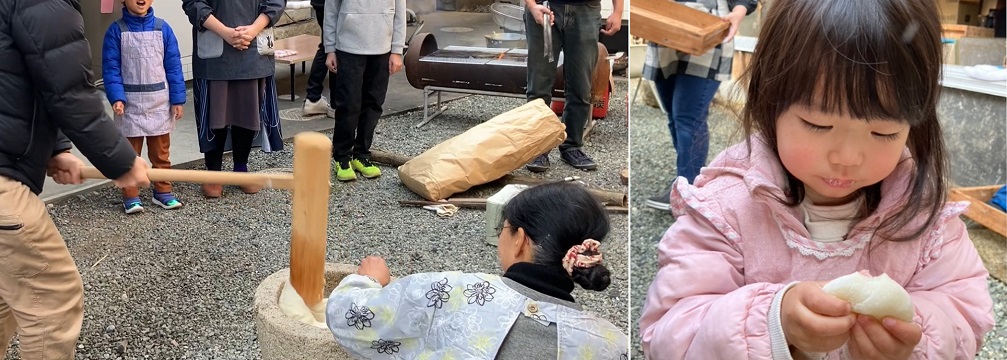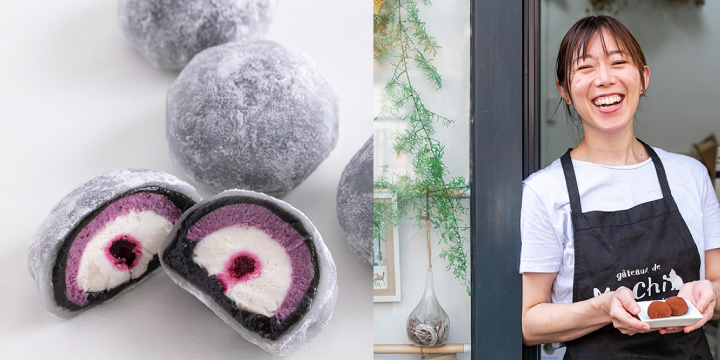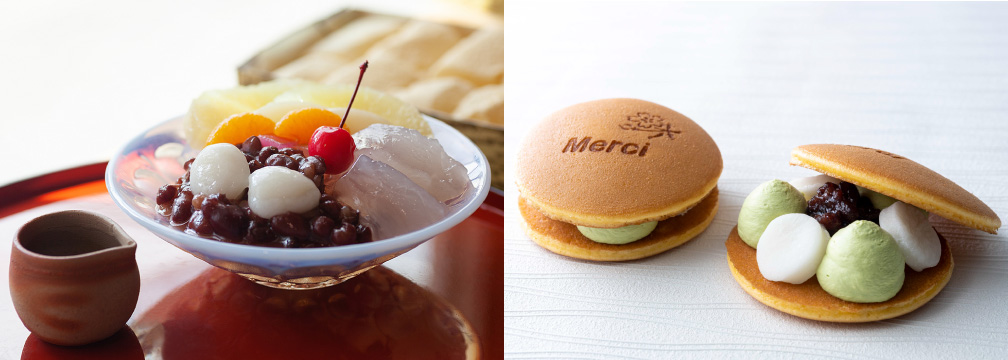News & Blogs
Mochi's Evolution from Traditional Treat to Chewy Culinary Sensation
Celebrating the New Year with Family Mochi Pounding Joy
Quality Control Challenge Behind Mochi's Sweet and Savory Versatility
Daifuku, Parisians' New Favorite Inspired by a Japanese Movie
Mochi: A Global Trotter in the World of Culinary Delights
In this blog, we touch on diverse topics about Japanese food cultures, practices together with the culinary secret, TREHA®, and its important role in the Japanese food industry. We hope our blog helps you obtain in-depth knowledge of the secrets and science behind Japanese cuisine, shared from our kitchen, to yours.
Mochi, Anyone?
Last fall, I had the privilege of joining Team TREHA® at the Mutual Trading Japanese Food & Restaurant Expo in New York, a premier event showcasing Japanese food, alcohol, beverage, and restaurant supplies. The show is held annually in New York and California, serving as the principal meeting place for food service professionals and suppliers. The team put its best effort into TREHA®’s signature benefits applicable to industry professionals including a cultural icon, the Japanese mochi ball (団子, dango).
Mochi (餅,もち) is a Japanese rice cake made of glutinous rice and water, renowned for its chewy texture and versatile nature, now rising as a popular frozen dessert in the US. It was a pleasant surprise for us that our guests presented more familiarity with the term “mochi” rather than “rice dumpling,” indicating that this simple rice cake finally became a member of the US gastronomy akin to yuzu, sake, and miso. Our initial intent was to introduce the moisture-retaining property of TREHA® using mochi balls as a sample. Interestingly, however, booth visitors often mistook us for a mochi manufacturer. “No, we don’t make mochi, but we can tell you how to make it,” I said this line at least five times while conversing with guests. Visitors were intrigued by the prospect of making mochi themselves. When I explained our recipe’s suitability of freezing for later use, I saw their eyes widen with surprise.
What is TREHA®? Please take a look here.

Mochi: Festive Food for More than 1,000 Years in Japan
Mochi, the beloved chewy rice cake, is created uniquely. It begins with glutinous rice, known as mochigome, which is first soaked overnight and then steamed to perfection. Once steamed, the rice is transferred to a traditional Japanese mortar (usu,臼) and pounded with heavy wooden mallets (kine,杵) in a rhythmic and almost ceremonial manner. This pounding, known as 'mochitsuki', is not just a method of preparation but a communal and celebratory event, often involving family and community members. The rhythmic pounding continues until the rice transforms into a smooth, sticky, and elastic dough. This dough is then skillfully hand-molded into various shapes, often round, to symbolize completeness and harmony.
Mochi’s simplicity allows for both savory and sweet dishes, making it adaptable as a snack, dessert, or a meal component. The counterpart in the Western culinary context can be bread, which encompasses styles from the lean French baguette, to the indulgent cinnamon roll, highlighting its diverse culinary potential.

While ready-made mochi is increasingly common in its homeland of Japan, round mochi, hand-molded into shapes reminiscent of the sun and moon, is not only a culinary delight but also a symbol of prosperity as it is made from the bountiful autumn rice harvest.
The art of mochi-making was once a cherished family activity, particularly in preparation for the New Year. My childhood memories easily conjure the mochi-pounding scenes involving a rhythmic dance around a stone mortar and a wooden mallet, with the sweet scent of steamed rice and the communal joy of shaping the fresh rice cake delight.
We taste the freshly pounded mochi in various traditional ways. Initially, it's relished with toppings like grated daikon radish, natto (fermented soybeans), or a dusting of kinako (grounded roasted soybeans), each lending its unique flavor to the chewy delight. Subsequently, we prepare mochi for New Year's traditions: crafting kagami-mochi, a decorative piece signifying longevity and prosperity, and shaping it for ozoni, a special soup that welcomes the New Year. The finale is to make special batches to create variations mixed with sweet potatoes, boiled azuki beans, or sakura shrimp, each adding a sweet or savory twist to this versatile treat.
Kagami-mochi and ozoni, the Japanese traditional food for New Year’s celebration
The dough in a stone mortar must be constantly turned to mash rice grain thoroughly during the pounding. This has to be done whenever a mallet is lifted from the sticky mochi dough. Grandmothers gracefully mastered this dangerous task. Their adeptness in this dangerous yet delicate process indicates their unrivaled culinary prowess, a sentiment likely agreed upon worldwide.

Watch the rhythmic mochi pounding video clip on Instagram @trehalose_sensei.
Endless Spin-offs and Challenges in Quality Control
Across different regions of Japan, countless mochi-based dishes and confections are crafted, utilizing unique local flavors. Those who have toured Japan may have observed an array of mochi treats available as souvenirs at train stations. Naturally, rice is the fundamental ingredient in mochi, making it an ideal choice for those following gluten-free, vegan, or low-allergen diets. A notable challenge with mochi and rice products is their hardening nature, especially once refrigerated, which is experience to many.
One may ponder how Japanese mochi treats in commercial packages maintain their fresh texture for three to six months. The secret to extending the longevity of the rice starch involves more than just preventing moisture loss with packaging. A significant part of the solution lies in the skillful combination of sugars to produce mochi that stays soft and chewy and even endures freeze-thaw cycles.
Experiment with recipes here for mochi that can be stored frozen. Do not worry; we made the recipe easy enough to make a unique treat without needing a giant stone mortar and mallet.
Team TREHA®'s Top Recommended Recipe
Strawberry Mochi Ice Cream Wraps
This is a basic mochi dough recipe using TREHA®. Mastering the dough preparation allows for creative customization of the fruit filling. Click here for the recipe.

Japanese mochi balls (Mitarashi Dango dumplings)
A time-honored traditional recipe alongside a healthy, effortless tofu-based variant. It's perfect for vegans and those seeking gluten-free options. Click here for the recipe.

Success of Gâteaux de Mochi in Paris
Rice is compatible with a wide array of ingredients. Its low allergenic nature makes it a universally adaptable grain. The recent surge in the popularity of daifuku (mochi filled with sweet bean paste) in Paris indicates the potential for mochi treats to prevail worldwide. The trend was sparked by a Japanese movie portraying heartfelt human drama in a Wagashi (Japanese confectionery) shop. Consequently, Parisian patisseries increasingly offer these novel foreign delicacies by fusing traditional French elements. Parisians, known for their refined palates, eagerly line up on street corners to indulge in these innovative and delectable creations. Please refer to the featured recipes from the acclaimed Parisian mochi patisserie "Gâteaux de Mochi."
The mochi's round shape and smooth surface appealed to the French as a metaphor for completeness (or perfection). This affinity laid the groundwork for the “Neo Wagashi” trend fueled by the recent French culinary concept of “reconstruction,” a harmonious blend of food with a millennium-long history and modern culinary innovation. French chefs are reimagining mochi, complementing its chewy texture with classic European flavors such as fruit jellies, jams, nuts, ganache, and cream.

The transformative magic of culinary fusion isn't limited to mochi; it's also starting to redefine “anko (sweet bean paste),” a key component of traditional Japanese confectionery. In the West, beans are predominantly used in savory dishes. Reimagining beans in a sweet context can be a great challenge that reshapes traditional Western culinary norms. This evolution in taste and perception can influence how Westerners view mochi, especially altering the current association with mochi ice cream.

Left: Anmitsu(あんみつ), Right: Dorayaki (どらやき)with Shiratama-Dango(白玉団子)
The World Adventure of Mochi Has Just Begun
I am proud to see that mochi, of Japanese origin, has become a culinary term in English and gained a stable position as a frozen dessert in the US. The journey of mochi, however, extends far beyond just frozen treats. I believe it will continuously evolve, assimilating traditional and non-traditional elements, promising a future rich with culinary innovation and diversity. It's a development that certainly keeps our eyes eagerly watching.
Did you find this blog interesting?
Please share it with your friends in the food service industry.
We regularly update the blog about the food culture of Japan, where TREHA® was discovered for culinary applications.
Click here and send us a message to subscribe.
Or hit us up on Instagram @trehalose_sensei!
You might also be interested in:
Mochi + TREHA®, the recipe booklet of mochi and Japanese confectionery is published!
Sugar 101 [Lesson 1] : The importance of sugar - It’s not just sweet!
Exclusive interview with professor Toru Suzuki, an authority on the phenomenon of freezing and the science of frozen foods:
#1 of 3, #2 of 3, #3 of 3

